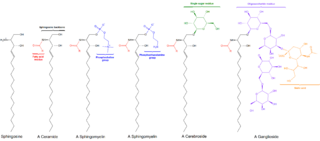Related Research Articles

Sphingolipids are a class of lipids containing a backbone of sphingoid bases, a set of aliphatic amino alcohols that includes sphingosine. They were discovered in brain extracts in the 1870s and were named after the mythological sphinx because of their enigmatic nature. These compounds play important roles in signal transduction and cell recognition. Sphingolipidoses, or disorders of sphingolipid metabolism, have particular impact on neural tissue. A sphingolipid with an R group consisting of a hydrogen atom only is a ceramide. Other common R groups include phosphocholine, yielding a sphingomyelin, and various sugar monomers or dimers, yielding cerebrosides and globosides, respectively. Cerebrosides and globosides are collectively known as glycosphingolipids.

Sphingomyelin is a type of sphingolipid found in animal cell membranes, especially in the membranous myelin sheath that surrounds some nerve cell axons. It usually consists of phosphocholine and ceramide, or a phosphoethanolamine head group; therefore, sphingomyelins can also be classified as sphingophospholipids. In humans, SPH represents ~85% of all sphingolipids, and typically make up 10–20 mol % of plasma membrane lipids.

Ceramides are a family of waxy lipid molecules. A ceramide is composed of sphingosine and a fatty acid. Ceramides are found in high concentrations within the cell membrane of eukaryotic cells, since they are component lipids that make up sphingomyelin, one of the major lipids in the lipid bilayer. Contrary to previous assumptions that ceramides and other sphingolipids found in cell membrane were purely supporting structural elements, ceramide can participate in a variety of cellular signaling: examples include regulating differentiation, proliferation, and programmed cell death (PCD) of cells.

Lipid signaling, broadly defined, refers to any biological signaling event involving a lipid messenger that binds a protein target, such as a receptor, kinase or phosphatase, which in turn mediate the effects of these lipids on specific cellular responses. Lipid signaling is thought to be qualitatively different from other classical signaling paradigms because lipids can freely diffuse through membranes One consequence of this is that lipid messengers cannot be stored in vesicles prior to release and so are often biosynthesized "on demand" at their intended site of action. As such, many lipid signaling molecules cannot circulate freely in solution but, rather, exist bound to special carrier proteins in serum.

Sphingomyelin phosphodiesterase is a hydrolase enzyme that is involved in sphingolipid metabolism reactions. SMase is a member of the DNase I superfamily of enzymes and is responsible for breaking sphingomyelin (SM) down into phosphocholine and ceramide. The activation of SMase has been suggested as a major route for the production of ceramide in response to cellular stresses.
Sphingosine-1-phosphate (S1P) is a signaling sphingolipid, also known as lysosphingolipid. It is also referred to as a bioactive lipid mediator. Sphingolipids at large form a class of lipids characterized by a particular aliphatic aminoalcohol, which is sphingosine.

Sphingosine kinase 1 is an enzyme that in humans is encoded by the SPHK1 gene.
Ceramidase is an enzyme which cleaves fatty acids from ceramide, producing sphingosine (SPH) which in turn is phosphorylated by a sphingosine kinase to form sphingosine-1-phosphate (S1P).
In enzymology, a ceramide kinase, also abbreviated as CERK, is an enzyme that catalyzes the chemical reaction:

The ASAH1 gene encodes in humans the acid ceramidase enzyme.

Neutral ceramidase is an enzyme that in humans is encoded by the ASAH2 gene.

Sphingomyelin phosphodiesterase 3 is an enzyme that in humans is encoded by the SMPD3 gene.

Sphingomyelin phosphodiesterase 2 is an enzyme that in humans is encoded by the SMPD2 gene.

Sphingosine-1-phosphate lyase 1 is an enzyme that in humans is encoded by the SGPL1 gene.

Sphingosine-1-phosphate phosphatase 1 is an enzyme that in humans is encoded by the SGPP1 gene.

Alkaline ceramidase 1 also known as ACER1 is a ceramidase enzyme which in humans is encoded by the ACER1 gene.

Alkaline ceramidase 3 also known as ACER3 is a ceramidase enzyme which in humans is encoded by the ACER3 gene.

Sphingosine kinase 2 is a protein that in humans is encoded by the SPHK2 gene.
Ceramide synthase 4 (CerS4) is an enzyme that in humans is encoded by the CERS4 gene and is one of the least studied of the ceramide synthases.
Ceramide synthase 5 (CerS5) is the enzyme encoded in humans by the CERS5 gene.
References
- ↑ "Human PubMed Reference:". National Center for Biotechnology Information, U.S. National Library of Medicine.
- ↑ Avramopoulos D, Wang R, Valle D, Fallin MD, Bassett SS (April 2007). "A novel gene derived from a segmental duplication shows perturbed expression in Alzheimer's disease". Neurogenetics. 8 (2): 111–20. doi:10.1007/s10048-007-0081-5. PMID 17334805.